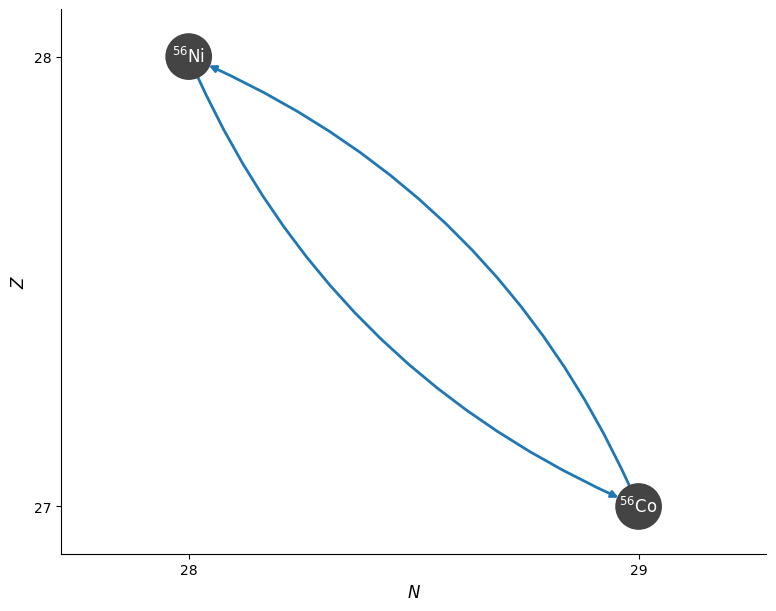Tabulated Weak Rate Example#
Here we walk through an example of a single network consisting of just 2 nuclei linked together by electron-capture and beta-decay.
We’ll consider \({}^{56}\mathrm{Ni}\) and \({}^{56}\mathrm{Co}\). The evolution of this system is:
where \(Y_\mathrm{Ni}\) and \(Y_\mathrm{Co}\) are the molar fractions of the nuclei.
Let’s create a network with these rates.
pynucastro will use the tabulated rates from Langanke and Martínez-Pinedo [2001].
import pynucastro as pyna
We access the tabular rates from TabularLibrary. Alternately, for this example, we could directly use LangankeLibrary.
tl = pyna.TabularLibrary()
lib = tl.linking_nuclei(["ni56", "co56"])
lib
Ni56 + e⁻ ⟶ Co56 + 𝜈 [Q = 2.13 MeV] (Ni56 --> Co56 <tabular_langanke>)
Co56 ⟶ Ni56 + e⁻ + 𝜈 [Q = -2.13 MeV] (Co56 --> Ni56 <tabular_langanke>)
We’ll create a RateCollection so we can evaluate the rates easily
rc = pyna.RateCollection(libraries=[lib])
fig = rc.plot(curved_edges=True)

Let’s create a Composition—we’ll make equal amounts of Ni and Co
comp = pyna.Composition(rc.unique_nuclei)
comp.set_equal()
We can see from the electron fraction that we are a little neutron-rich
Ye = comp.ye
Ye
0.4910714285714286
Now let’s compute the rates. We’ll pick a density (actually \(\rho Y_e\)) and temperature right on one of the points tabulated in the original source so we can directly compare to what is in the table.
rho = 1.e7 / Ye
T = 1.e9
The rates are proportional to the molar fractions, so we can get those too (via get_molar):
Y = comp.get_molar()
Y
{Co56: 0.008928571428571428, Ni56: 0.008928571428571428}
Now we can evaluate the rates using evaluate_rates:
rc.evaluate_rates(rho, T, comp)
{Co56 ⟶ Ni56 + e⁻ + 𝜈: 2.6914293082016787e-23,
Ni56 + e⁻ ⟶ Co56 + 𝜈: 7.240723730837853e-06}
We can also compute \(dY/dt\) for the network via evaluate_ydots:
ydots = rc.evaluate_ydots(rho, T, comp)
ydots
{Co56: 7.240723730837853e-06, Ni56: -7.240723730837853e-06}
If we look at the original tables from Langanke and Martínez-Pinedo [2001], they tabulate (for the conditions we selected above):
neg. daughter Ni56 z=28 n=28 a=56 Q= -1.6240
pos. daughter Co56 z=27 n=29 a=56 Q= 1.6240
+++ Ni56 --> Co56 +++ --- Co56 --> Ni56 ---
t9 lrho uf lbeta+ leps- lrnu lbeta- leps+ lrnubar
...
1.00 7.0 0.689 -15.299 -3.091 -3.097 -20.521 -23.856 -20.878
...
We see that there are 2 rates for \({}^{56}\mathrm{Ni} \rightarrow {}^{56}\mathrm{Co}\): positron decay (lbeta+) and electron capture (leps-), and 2 rates for \({}^{56}\mathrm{Co} \rightarrow {}^{56}\mathrm{Ni}\): beta-decay (lbeta-) and positron capture (leps+). All of these are log base-10 in \(\mathrm{s}^{-1}\).
In this case, the dominant rate is the electron capture. Let’s compute that rate manually
lambda_ec = 10.0**-3.091
r = Y[pyna.Nucleus("ni56")] * lambda_ec
r
7.240723730837861e-06
We get the same result as evaluate_rates()!
Finally, we can compute the evolution of the electron fraction:
dyedt = sum(q.Z * ydots[q] for q in rc.unique_nuclei)
dyedt
-7.240723730837865e-06
